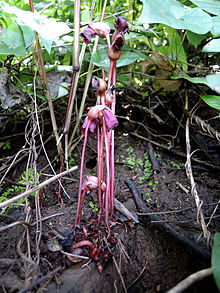Aeginetia indica
Appearance
| Aeginetia indica | |
|---|---|

| |
| Forest ghost flower, Aeginetia indica | |
| Scientific classification | |
| Kingdom: | Plantae |
| Clade: | Tracheophytes |
| Clade: | Angiosperms |
| Clade: | Eudicots |
| Clade: | Asterids |
| Order: | Lamiales |
| Family: | Orobanchaceae |
| Genus: | Aeginetia |
| Species: | A. indica
|
| Binomial name | |
| Aeginetia indica Linnaeus, 1753
| |
Aeginetia indica, commonly known as Indian broomrape[1] or forest ghost flower, is a holoparasitic herb or root parasite of the plant family Orobanchaceae. It grows in moist deciduous and semi-evergreen forests of tropical and subtropical Asia and New Guinea.[2][3][4] It parasitises plants of the families Cannaceae, Commelinaceae, Cyperaceae, Juncaceae, Poaceae, and Zingiberaceae.[5]
In many regions, including the Nepal Eastern Himalayas, Aeginetia indica is used for medicinal and ritual purposes.[6] For example, the entire plant is placed in shrines or on altars during the Teej festival as a symbol of Shiva and Parvati.
References
[edit]- ^ English Names for Korean Native Plants (PDF). Pocheon: K noorea National Arboretum. 2015. p. 343. ISBN 978-89-97450-98-5. Archived from the original (PDF) on 25 May 2017. Retrieved 25 January 2016 – via Korea Forest Service.
- ^ Aeginetia indica. In: Plants of the World Online London, Kew.
- ^ Aeginetia indica (forest ghost flower), Vélez-Gavilán J, 2019. Invasive Species Compendium. Wallingford, UK
- ^ "Forest Ghost Flower". FlowersofIndia.net. Retrieved 14 Jan 2014.
- ^ "Aeginetia indica". Orowiki. Archived from the original on December 21, 2011. Retrieved 14 Jan 2014.
- ^ O'Neill, Alexander; Rana, Santosh (2017-07-16). "An ethnobotanical analysis of parasitic plants (Parijibi) in the Nepal Himalaya". Journal of Ethnobiology and Ethnomedicine. 12 (14): 14. doi:10.1186/s13002-016-0086-y. PMC 4765049. PMID 26912113.
